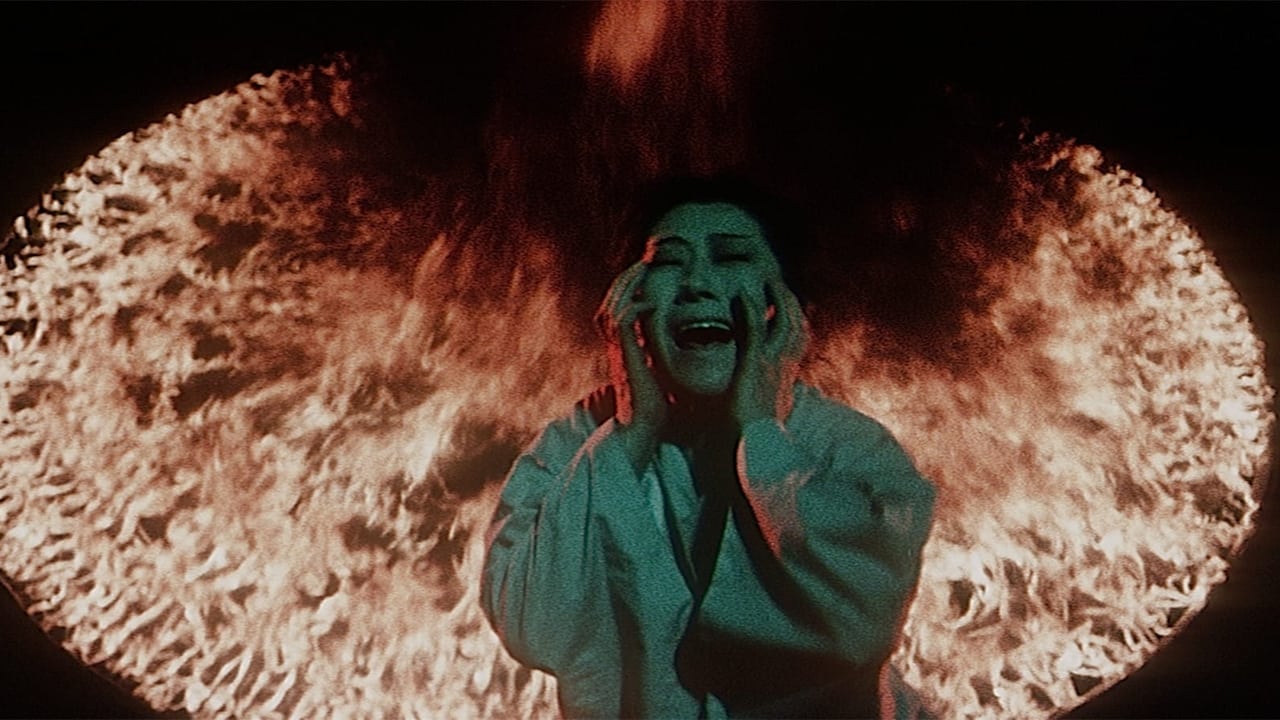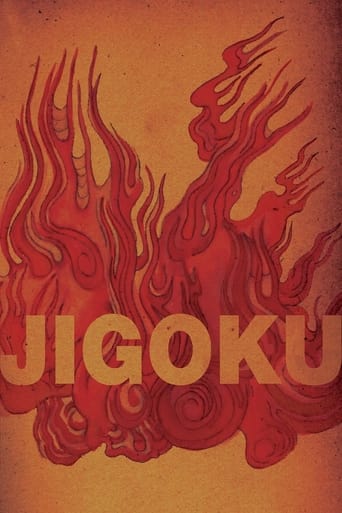Afouotos
Although it has its amusing moments, in eneral the plot does not convince.
WillSushyMedia
This movie was so-so. It had it's moments, but wasn't the greatest.
Darin
One of the film's great tricks is that, for a time, you think it will go down a rabbit hole of unrealistic glorification.
Francene Odetta
It's simply great fun, a winsome film and an occasionally over-the-top luxury fantasy that never flags.
ferbs54
The seismic, tsunamic and nuclear events that transpired in Japan in March 2011 have served to demonstrate quite dramatically that sometimes, life on Earth can be a living hell. For a glimpse at a more traditional Japanese vision of Hades, though, one need look no further than Nobuo Nakagawa's 1960 film "Jigoku" (or, "hell"), a picture whose reputation seems to be on the rise lately, thanks in part to this great-looking Criterion DVD. I had only seen one of Nakagawa's 96 other films before taking in "Jigoku," and that was 1968's "Snake Woman's Curse," a well-done if lighthearted tale of ghostly vengeance told in the EC Comics manner. "Jigoku" is a whole different kettle of fugu, and easily the more impressive picture. In it, we meet a young student named Shiro, played by the handsome and very likable Shigeru Amachi. Newly engaged, his life takes a decisive turn when he is involved in a hit-and-run accident one night, and is unable to convince his demonic acquaintance, Tamura (Yoichi Numata)--the actual driver of the car--to report the incident. Before long, every person in Shiro's life begins to meet an early demise, in advance of the journey to the realm down under (and no, I don't mean Australia!)."Jigoku," though over 50 years old now, feels surprisingly modern, with great use of color and a strong emphasis on jazz, drugs and femme fatales. The film's first 1/3, the Tokyo segment, could almost be a Japanese noir, with its yakuza and nightclub elements. The central section slows down a bit, as Shiro goes to his parents' old-age home in the country. But even during this slow stretch, Nakagawa manages to hold our interest with some surprising bursts of violence and the utilization of moody lighting and bizarre camera angles. The film's final 1/3, however, is something else again, when virtually every character in the film is judged and suffers all the myriad torments and tortures in hell. In this segment, the patient horror buff is treated to numerous fire pits, skewerings, a severing of hands, flayings, eye gouging, the shattering of teeth, a lake of blood, cesspool fountains, a vortex of massed sufferers and on and on; truly, a hellacious environment, made even more memorable via the film's use of expressionistic sets. Do all the film's characters deserve such a horrible end? Hell, no! Shiro's only sin seems to be that he is a victim of fateful happenstance, and his fiancée's, some mere premarital sex. Enma, the so-called King of Hell here, can be SO strict! Regardless, this is some pretty impressive work. From its opening dirge regarding the briefness of man's stay on Earth to its closing image of "lotus blossom purification," "Jigoku" is a film that should keep all potential sinners on the straight and narrow....
Michael_Elliott
Jigoku (1960) ** 1/2 (out of 4) A college student (Shigern Amachi) has his life literally go to Hell after he and a buddy accidentally run down a drunken gangster who jumps out in front of their car. Soon afterwards everyone in the student's life begin to die and his guilt eventually leads him to Hell. This is certainly a very strange and surreal film that has the same structure as the director's previous film Ghost Story of Yotsura as it gives us a lot of backstory before it gets down to the meat of the film. Perhaps because I'm from a different religious background I couldn't get overly involved with the story because I had a hard time believing so much evil and bad would come to our main guy just because of the accident that happened. He didn't do it on purpose, he felt bad about it and all the blame would go to his friend that was driving. For the student to be damned to Hell for what he did and to have to suffer through various deaths just seemed a bit too much for me and this dragged down the first hour of the film for me. After the hour mark when we finally get to Hell is when things begin to pick up with the bizarre visuals and (for the time) graphic death scenes. I've heard a few call this the first gore film and perhaps that's true as we get some rather bloody violence including a man getting cut into pieces, an eye ripped out and hands being ripped off. This stuff certainly isn't as graphic as the stuff of today but I'm sure it caused quite a commotion back in the day. The various stages of Hell were perfectly done and contains a lot of imagination. I loved the various stages that our student has to go through and many of them managed to be quite creepy. The scene where the people of Hell are begging for water was beautifully done. Perhaps a second viewing would change my opinion on the start of the film but as for now I felt it really dragged too slowly.
ebossert
Have you ever watched a film so horrible that you simply could not reconcile its atrociousness with its glowing IMDb rating? I had this experience after watching Jigoku earlier today. The IMDb reviews were raving harder than a teenager after midnight – with terms like "masterpiece" being thrown around, apparently on a whim. I was expecting this film to be pretty good. Nothing prepared me for the absolute disaster I was about to see.Where to begin? Let's start with the single worst aspect of Jigoku – the acting. I'm not exaggerating when I say that the acting consists of some of the most systematically awful performances I've seen in any movie . . . ever. A typical bad film will have various moments of deficient acting, but Jigoku is systematically deficient, meaning that there are extremely long periods of time where just about everyone on screen is stinking the place out. For example, the latter half of the film – which takes place in Japanese Hell – is basically a 45-minute trainwreck that is the epitome of quintessential artificiality. The centerpiece of which is perhaps the scene with the lead character falling awkwardly after someone disappears near the river. But there are so many badly-acted moments that it would require booklength treatment to cover it all. However, the viewer should look forward to the food poisoning scene, which makes a Sci-Fi Channel Original Film look Oscar worthy.What else is wrong with Jigoku? Everything – storyline, character development, etc. – can be summarily described as unintentionally hilarious.Cheap, ineffective scares and downright stupid deaths are used. One such scene occurs midway thru when two people trip on a rope bridge. The movie then cuts to their stunt-dummies falling onto some hard rocks below. It was probably meant to be horrifying, but it came off as exceedingly funny. The character who runs over the Yakuza drunk was so damn slow in applying the brakes that it was reminiscent of Austin Powers when the steamroller was slowly approaching the screaming baddie from fifty yards away. The subsequent death of the girl in another car accident was also stupifying, especially considering how her boyfriend was sitting right next to her yet suffered no injuries whatsoever. Perhaps the funniest series of deaths take place during the punishment of random dudes in hell. Just look for the dude who gets "flayed", which will undoubtedly have the viewer rolling hysterically.At one point the movie shows extreme closeups of random people screaming at the camera, which gets very annoying.The finale has the lead character run in ultra cheesy fashion (in slow-motion) after his baby, which is strapped onto a big, turning wheel. I saw the baby on the wheel the first time, but the filmmakers inexplicably found it necessary to repeat the same exact scene over a dozen times. Imagine a 3-second scene being repeated over and over and over again every few seconds. It's almost as if the filmmakers weren't so much intending on depicting hell as they were attempting to INFLICT hell on the viewer with this pathetic attempt at film-making.To supplement the horrible finale with the spinning baby, the lead character jumps in an attempt to save the child, but mis-times it so badly that he ends up on the OPPOSITE SIDE of the giant wheel. I knew this guy was stupid, but it doesn't get any more moronic than that.Some gore (that was a ahead of its time) and a few scenes with fantastic imagery could have saved this one from the cinema sewer, but everything else is of such an unbelievably low quality that this film easily steamrolls to the bottom of the barrel.
christopher-underwood
I guess this doesn't really belong with my more extreme reviews but for all it's stunningly beautiful scenes, it's heavily symbolic imagery and symbolism this still, even over 40 years, has a punch or two to unleash. It is for the most part a tragic tale that involves an almost laughable number of deaths and other misfortunes but hell always beckons. The last half hour or so is a considerably finely worked series of hellish landscapes with not a little graphic violence that could certainly not have been shown in the UK in 1960. Along the way there are many delights and a cool jazzy score. Fascinating, groundbreaking and most enjoyable.

